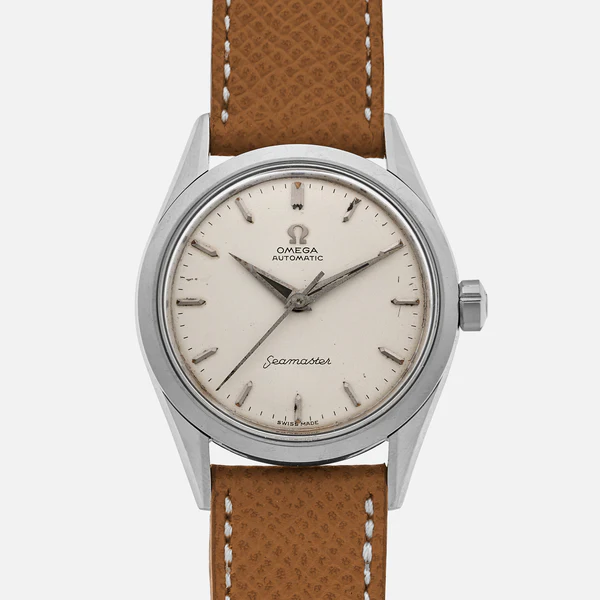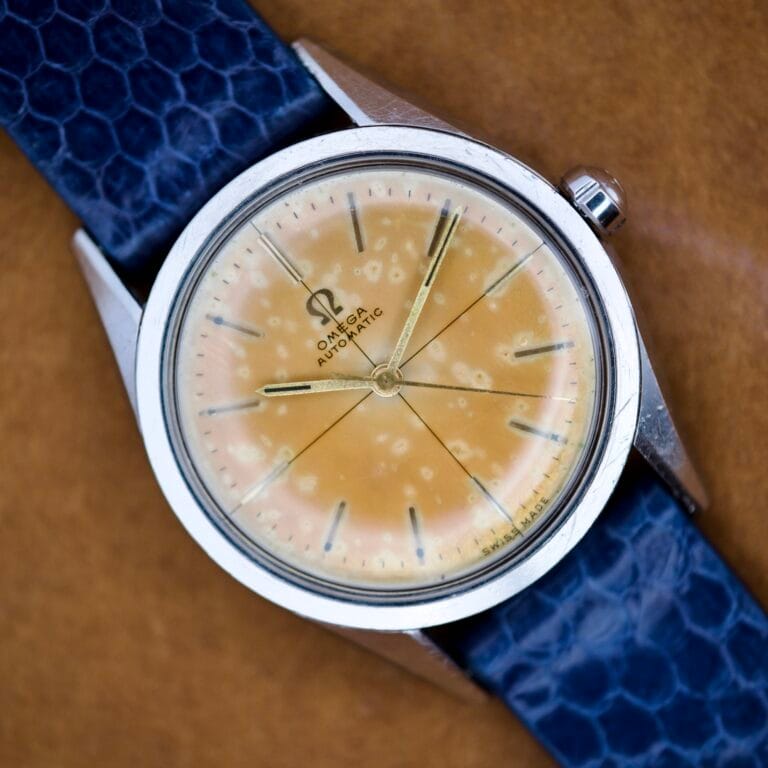Don't miss the next drop
Omega Seamaster 2802
Last updated: July 22, 2025

Brand:
Model Line:
Production Period:
1954-1957
Caliber/s:
Case Width:
34mm
Case Height:
41mm
Lug Width:
18mm
Omega Seamaster 2802 Description
The Omega Seamaster Reference 2802 is a vintage wristwatch that graced the horological scene primarily between 1954 and 1957, with some availability potentially extending to 1960. This model is a key representative of the Seamaster line’s evolution in the post-war era, skillfully blending Omega’s renowned robustness with an increasing emphasis on civilian elegance. The Seamaster 2802, particularly its “De Luxe” iterations, often featured precious metal cases (solid 18K gold or gold-capping) and refined dial treatments, such as honeycomb textures. It is predominantly powered by the Omega Caliber 471, one of the brand’s early and successful full-rotor automatic movements, noted for its reliability and its use in the commemorative Seamaster XVI for the 1956 Melbourne Olympics. The reference is distinguished by its classic mid-century design, typically around 34mm in case diameter, and its versatile “town, sea and country” appeal.
Specifications
| Reference Number | 2802 (with suffixes like -1SC, -2SC, -4SC, -7SC, -13SC; and material prefixes CK, OT) |
| Production Year(s) | Circa 1954 – 1957 (potentially available until 1960) |
| Movement Caliber | Omega Caliber 471 (Automatic, Full Rotor) |
| Movement Type | Automatic |
| Case Diameter | Approx. 34mm (excluding crown) |
| Case Material(s) | Stainless Steel (CK), 18K Solid Gold (OT), Gold-Capped on Stainless Steel |
| Lug Style | Often faceted or “pointed” |
| Case Back | Press-in / Snap-on |
| Dial Colors/Textures | Silver/Cream/White, Black (rare), Honeycomb (sought-after), Linen (rare), Tropical (patinated) |
| Hands | Dauphine, Pencil (often with Radium lume) |
| Hour Markers | Applied (Dart, Bar, Arrowhead), often gold or pink gold |
| Crystal | Acrylic (Plexiglass), often Omega signed |
| Lug Width | 18mm |
| Water Resistance (Original) | 3 bar (30 meters / 100 feet) for CK 2802 & OT 2802. Not guaranteed today. |
| Lume | Radium |
Key Details & Variations
Variations
The Omega Seamaster 2802 series is characterized by a number of notable variations:
- Reference Suffixes & Prefixes:
- SC: Commonly appended to numerical suffixes (e.g., 2802-1SC, 2802-4SC), “SC” most credibly stands for “Seconde Centrale” (Central Second), indicating a sweep seconds hand, consistent with the Caliber 471 movement.
- Numerical Suffixes: Digits like -1, -2, -4, -7, -13 likely denote minor evolutionary changes in case design, dial execution, or specific production batches during the model’s lifespan.
- CK: This prefix (e.g., CK 2802) typically signifies a stainless steel case in Omega’s vintage nomenclature.
- OT: This prefix (e.g., OT 2802) indicates a case made entirely of solid gold, usually 18K (“Or Total”).
- Case Materials: The 2802 was available in stainless steel , solid 18K gold (yellow or rose) , and gold-capped over stainless steel (often 14K).
- Dial Designs:
- Colors: Silver, cream, and white were common. Original black dials are rarer and highly valued. Some dials developed a “tropical” patina.
- Textures: The “honeycomb” or “waffle” texture is a particularly sought-after and distinctive feature, often associated with “De Luxe” models. A rare “linen” texture has also been noted.
- Indices: Applied hour markers were standard, often faceted and in gold or pink gold. Styles included dart, bar, or arrowhead shapes.
- “De Luxe” Designation: Reference 2802 was marketed as the Seamaster ‘De Luxe’, particularly when featuring precious metal cases (solid gold or gold-capped) and more refined dial finishes like honeycomb textures.
Correct Dial
- Markings: Signed “Omega,” “Automatic,” and “Seamaster.” The “De Luxe” designation might appear on some dials. “SWISS MADE” or “SWISS” is typically found at the 6 o’clock position.
- Omega Logo & “Seamaster” Script: The applied Omega logo (Ω) should be sharply defined. The style of the “Seamaster” script should be consistent with Omega’s typography of the mid-1950s.
- Lume: Original Radium lume on hands and often as small dots accompanying hour markers, which patinates over time.
Correct Hands
- Style: Dauphine or Pencil hands are characteristic, often matching the material of the hour markers.
- Lume: May feature Radium luminous inserts, consistent with the dial lume.
Correct Case
- Shape and Dimensions: Typically 33mm-34.5mm diameter (excluding crown), with a lug width of 18mm. Lug-to-lug length is around 40-41mm, and thickness is about 10-11mm.
- Lugs: Often described as “handsome, faceted lugs” or “pointed lugs”.
- Case Back: Predominantly press-in or snap-on type. May be engraved “SEAMASTER” and/or “WATERPROOF”. Later 1950s examples might feature the Omega Hippocampus logo.
- Internal Markings: Inside case back should have Omega Watch Co. markings, “FAB. SUISSE,” “SWISS MADE,” full reference number (e.g., 2802-4 SC), and material indication (e.g., “ACIER INOXYDABLE” or gold hallmarks). Case maker marks (e.g., CB, HF) may be present.
- Crown: Original Omega-signed crown, with period-correct styles.
Additional Details
The Omega Seamaster 2802 is predominantly powered by the Omega Caliber 471:
- Type: Automatic with a full (360-degree) bi-directionally winding rotor; one of Omega’s first successful full-rotor designs.
- Jewels: Typically 19 or 20 jewels.
- Frequency: 19,800 vph (2.75 Hz).
- Power Reserve: Approximately 46 hours.
- Shock Protection: Incabloc system.
- Finish: Characteristic copper-colored (gilt) finish on movement plates.
- Historical Note: The Caliber 471 was notably used in the Omega Seamaster XVI, a special edition for the 1956 Melbourne Olympic Games, underscoring its quality and precision.
- Erroneous Caliber Mentions: Isolated listings mentioning Caliber 490 (a sub-second movement) or Caliber 451 (not a recognized Omega automatic for this series) in a Ref. 2802 SC are highly likely to be errors or indicative of non-original movements.
Original crystals were made of acrylic (Plexiglass/Hesalite), often featuring a tiny, centrally etched Omega logo (Ω) as an authenticity mark.
The Seamaster 2802 is a well-regarded vintage Omega, offering good value for its 1950s charm and reliable early full-rotor automatic movement.
- Value Factors: Condition (especially dial and unpolished case), originality of all parts, case material (solid gold highest), and dial rarity (honeycomb, linen, black, tropical patina) are key drivers.
- Price Range: Varies widely. Gold-plated models in fair condition might be found around $450-$500 (head only), while well-preserved examples, especially solid gold or those with rare dials, can exceed $2,000.
- Movement Verification: Confirm genuine Omega Caliber 471 with correct markings (Omega name, caliber number, jewel count), copper plating, and period-appropriate serial number (e.g., 14.xxx.xxx for c. 1955; 16.xxx.xxx for 1956/57).
- Case Markings: Check for correct Omega branding, reference number (2802 and suffix), and material indicators inside the case back. Solid gold cases should have Swiss hallmarks.
- Dial and Hands: Scrutinize for crisp printing, correct Omega logo and “Seamaster” script style for the 1950s, and consistent aging of original Radium lume.
- Crown & Crystal: Look for an original Omega-signed crown and potentially a signed crystal.
As an eBay Partner, we may be compensated if you make a purchase.



